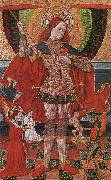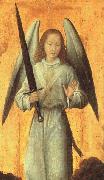Wholesale Oil Painting No Minimum |
|||||||||||
|
|
|||||||||||

|
|||||||||||
|
|
|
||||||||
Hans MemlingNetherlandish Northern Renaissance Painter, ca.1435-1494 Born in Seligenstadt, near Frankfurt in the Middle Rhein region, it is believed that Memling served his apprenticeship at Mainz or Cologne, and later worked in the Netherlands under Rogier van der Weyden (c. 1455?C1460). He then went to Bruges around 1465. There is an apocryphical story that he was a wounded at the Battle of Nancy, sheltered and cured by the Hospitallers at Bruges, and that to show his gratitude he refused payment for a picture he had painted for them. Memling did indeed paint for the Hospitallers, but he painted several pictures for them, in 1479 and 1480, and it is likely that he was known to his patrons of St John, prior to the Battle of Nancy. Memling is connected with military operations only in a distant sense. His name appears on a list of subscribers to the loan which was raised by Maximilian I of Austria, to defend against hostilities towards France in 1480. In 1477, when he was incorrectly claimed to have been killed, he was under contract to create an altarpiece for the gild-chapel of the booksellers of Bruges. This altarpiece, under the name of the Seven Griefs of Mary, is now in the Gallery of Turin. It is one of the fine creations of his more mature period. It is not inferior in any way to those of 1479 in the hospital of St. John, which for their part are hardly less interesting as illustrative of the master's power than The Last Judgment which can be found since the 1470s in the St. Mary's Church, Gda??sk. Critical opinion has been unanimous in assigning this altarpiece to Memling. This affirms that Memling was a resident and a skilled artist at Bruges in 1473; for the Last Judgment was undoubtedly painted and sold to a merchant at Bruges, who shipped it there on board of a vessel bound to the Mediterranean, which was captured by Danzig privateer Paul Beneke in that very year. This purchase of his pictures by an agent of the Medici demonstrates that he had a considerable reputation. |
||||||||
|
|
||||||||
The Archangel Michael
The Archangel Michael Painting ID:: 2927 |
1480
Wallace Collection, London 1480 Wallace Collection, London |
|||||||
|
|
||||||||
|
|
||||||||
|
|
The Archangel Michael
The Archangel Michael Painting ID:: 41789 |
mk165
From the Church of Saints-Cyrius and juliette
Lagourka
Georgia
mk165 From the Church of Saints-Cyrius and juliette Lagourka Georgia |
||||||
|
|
||||||||
|
|
||||||||
|
|
The Archangel Michael
The Archangel Michael Painting ID:: 41839 |
mk165
33x50
From the Church of the Exaltation of the Holy Cross
Drogobytch
mk165 33x50 From the Church of the Exaltation of the Holy Cross Drogobytch |
||||||
|
|
||||||||
Pietro PeruginoItalian 1450-1523 Pietro Perugino Galleries Italian painter and draughtsman. He was active in Perugia, Florence and Rome in the late 15th century and early 16th. Although he is now known mainly as the teacher of Raphael, he made a significant contribution to the development of painting from the style of the Early Renaissance to the High Renaissance. The compositional model he introduced, combining the Florentine figural style with an Umbrian use of structure and space, was taken up by Raphael and became widely influential throughout Europe. |
||||||||
|
|
||||||||
|
|
The Archangel Michael
The Archangel Michael Painting ID:: 42981 |
mk170
1496-1500
Oil on poplar
114x56cm
mk170 1496-1500 Oil on poplar 114x56cm |
||||||
|
|
||||||||
|
|
||||||||
|
|
The Archangel Michael
The Archangel Michael Painting ID:: 64921 |
127 x 78 cm Museu Nacional d'Art de Catalunya, Barcelona The archangel Michael was, like St. George the dragon-killer, one of the typically warlike saints so greatly approved in the age of chivalry. The Bible tells us that he fought with Satan for the body of Moses and we can read in the Apocalypse how he defeated the dragon with seven heads and ten horns. St. Michael was therefore looked upon as one of the principal patrons of the Church who, having overcome Satan, could protect all innocent souls from the Devil. This painting illustrates the somewhat provincial style of Juan de la Abadia of Huesca. The heritage of the Trecento can be seen in the delicate, girlish countenance of the saint and the brilliant tints of the wings, but blended with it is the elegance associated with the International Gothic style. The figures are wooden and lifeless and the artist's limited knowledge of anatomy may be seen in his representation of the soul; but the carefully arranged pattern of the floor creates the illusion of space, indicating that the artist was aware of the later developments of Gothic art and was to some extent influenced by early Renaissance art. , ABADIA, Juan de la , The Archangel Michael , 1451-1500 , Spanish , painting , religious 127 x 78 cm Museu Nacional d'Art de Catalunya, Barcelona The archangel Michael was, like St. George the dragon-killer, one of the typically warlike saints so greatly approved in the age of chivalry. The Bible tells us that he fought with Satan for the body of Moses and we can read in the Apocalypse how he defeated the dragon with seven heads and ten horns. St. Michael was therefore looked upon as one of the principal patrons of the Church who, having overcome Satan, could protect all innocent souls from the Devil. This painting illustrates the somewhat provincial style of Juan de la Abadia of Huesca. The heritage of the Trecento can be seen in the delicate, girlish countenance of the saint and the brilliant tints of the wings, but blended with it is the elegance associated with the International Gothic style. The figures are wooden and lifeless and the artist's limited knowledge of anatomy may be seen in his representation of the soul; but the carefully arranged pattern of the floor creates the illusion of space, indicating that the artist was aware of the later developments of Gothic art and was to some extent influenced by early Renaissance art. , ABADIA, Juan de la , The Archangel Michael , 1451-1500 , Spanish , painting , religious |
||||||
|
|
||||||||
Hans MemlingNetherlandish Northern Renaissance Painter, ca.1435-1494 Born in Seligenstadt, near Frankfurt in the Middle Rhein region, it is believed that Memling served his apprenticeship at Mainz or Cologne, and later worked in the Netherlands under Rogier van der Weyden (c. 1455?C1460). He then went to Bruges around 1465. There is an apocryphical story that he was a wounded at the Battle of Nancy, sheltered and cured by the Hospitallers at Bruges, and that to show his gratitude he refused payment for a picture he had painted for them. Memling did indeed paint for the Hospitallers, but he painted several pictures for them, in 1479 and 1480, and it is likely that he was known to his patrons of St John, prior to the Battle of Nancy. Memling is connected with military operations only in a distant sense. His name appears on a list of subscribers to the loan which was raised by Maximilian I of Austria, to defend against hostilities towards France in 1480. In 1477, when he was incorrectly claimed to have been killed, he was under contract to create an altarpiece for the gild-chapel of the booksellers of Bruges. This altarpiece, under the name of the Seven Griefs of Mary, is now in the Gallery of Turin. It is one of the fine creations of his more mature period. It is not inferior in any way to those of 1479 in the hospital of St. John, which for their part are hardly less interesting as illustrative of the master's power than The Last Judgment which can be found since the 1470s in the St. Mary's Church, Gda??sk. Critical opinion has been unanimous in assigning this altarpiece to Memling. This affirms that Memling was a resident and a skilled artist at Bruges in 1473; for the Last Judgment was undoubtedly painted and sold to a merchant at Bruges, who shipped it there on board of a vessel bound to the Mediterranean, which was captured by Danzig privateer Paul Beneke in that very year. This purchase of his pictures by an agent of the Medici demonstrates that he had a considerable reputation. |
||||||||
|
|
||||||||
|
|
The Archangel Michael
The Archangel Michael Painting ID:: 86836 |
Date c. 1479(1479)
Medium Oil on wood
Dimensions Height: 37 cm (14.6 in). Width: 16 cm (6.3 in).
cjr Date c. 1479(1479) Medium Oil on wood Dimensions Height: 37 cm (14.6 in). Width: 16 cm (6.3 in). cjr |
||||||
|
|
||||||||
|
Hans Memling Netherlandish Northern Renaissance Painter, ca.1435-1494 Born in Seligenstadt, near Frankfurt in the Middle Rhein region, it is believed that Memling served his apprenticeship at Mainz or Cologne, and later worked in the Netherlands under Rogier van der Weyden (c. 1455?C1460). He then went to Bruges around 1465. There is an apocryphical story that he was a wounded at the Battle of Nancy, sheltered and cured by the Hospitallers at Bruges, and that to show his gratitude he refused payment for a picture he had painted for them. Memling did indeed paint for the Hospitallers, but he painted several pictures for them, in 1479 and 1480, and it is likely that he was known to his patrons of St John, prior to the Battle of Nancy. Memling is connected with military operations only in a distant sense. His name appears on a list of subscribers to the loan which was raised by Maximilian I of Austria, to defend against hostilities towards France in 1480. In 1477, when he was incorrectly claimed to have been killed, he was under contract to create an altarpiece for the gild-chapel of the booksellers of Bruges. This altarpiece, under the name of the Seven Griefs of Mary, is now in the Gallery of Turin. It is one of the fine creations of his more mature period. It is not inferior in any way to those of 1479 in the hospital of St. John, which for their part are hardly less interesting as illustrative of the master's power than The Last Judgment which can be found since the 1470s in the St. Mary's Church, Gda??sk. Critical opinion has been unanimous in assigning this altarpiece to Memling. This affirms that Memling was a resident and a skilled artist at Bruges in 1473; for the Last Judgment was undoubtedly painted and sold to a merchant at Bruges, who shipped it there on board of a vessel bound to the Mediterranean, which was captured by Danzig privateer Paul Beneke in that very year. This purchase of his pictures by an agent of the Medici demonstrates that he had a considerable reputation. The Archangel Michael Date c. 1479(1479) Medium Oil on wood Dimensions Height: 37 cm (14.6 in). Width: 16 cm (6.3 in). cjr |
||||||||
|
|
||||||||
|
Prev Next
|
||||||||
|
|
||||||||
|
Related Paintings to Hans Memling :. |
||||||||
|
|
||||||||
|
CONTACT US |






